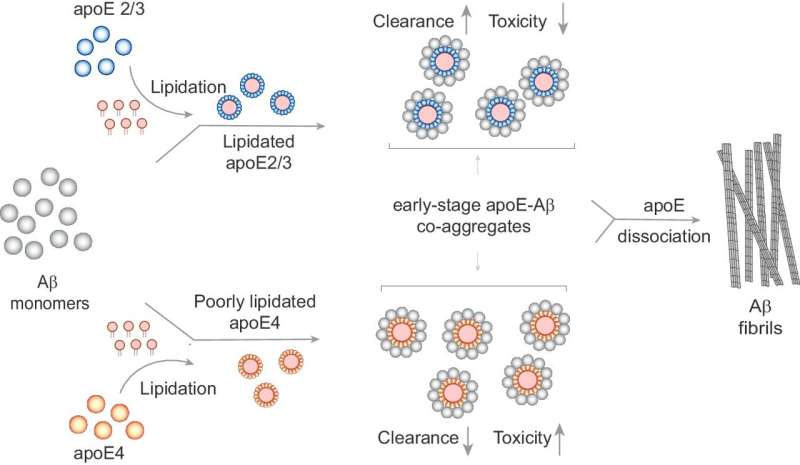This article has been reviewed according to Science X's editorial process and policies. Editors have highlighted the following attributes while ensuring the content's credibility:
fact-checked
peer-reviewed publication
trusted source
proofread
New genetic clue in understanding increased Alzheimer's risk

Scientists have discovered a new piece of the puzzle in understanding why some people are more susceptible to Alzheimer's disease. The research has been published in the journal Nature Communications.
The new research from the University of Sheffield's Institute of Translational Neuroscience (SITraN), together with scientists from the UK Dementia Research Institute at the University of Cambridge, reveals how a risk gene called apolipoprotein E (APOE) interacts with a protein known as amyloid-beta (Aβ), and how this interaction affects the likelihood of developing Alzheimer's disease.
Aβ protein buildup in brain tissue, forming clumps known as plaque, is a hallmark of Alzheimer's. This accumulation begins two to three decades before any symptoms appear, marking one of the earliest signs of dysfunction in the disease. This build-up process damages brain cells and impairs their functions, leading to symptoms such as memory loss. Therefore, stopping this accumulation process or mitigating the toxicity around this buildup is a potential therapeutic strategy.
The specific gene, known as APOE, is the most common risk gene linked to Alzheimer's disease. APOE comes in three common forms in humans. APOE2 is associated with a reduced risk of developing Alzheimer's. APOE3, the most common form, doesn't appear to affect the risk of the disease. However, APOE4 increases the risk significantly.
About one in seven healthy individuals carry two copies of the APOE4 gene. However, among people diagnosed with Alzheimer's disease, one out of every 2.5 patients carries this gene, highlighting the substantial risk it poses for developing the condition.
The Sheffield scientists connected these two fundamental events in Alzheimer's disease—how the inherited APOE gene is linked with developing Alzheimer's disease by modulating the Aβ build-up process.
They used an innovative approach by converting skin cells from humans into the type of brain cells and isolating Aβ protein clumps from patients' brains who have different versions of the APOE gene.
They found that all forms of the APOE gene interact with the Aβ protein during its early accumulation stages. However, the APOE4 variant of the gene causes Aβ to become more harmful to the brain cells and accelerates its buildup compared to the other variants of the gene.
Senior author of the study, Dr. Suman De from the University of Sheffield's Institute for Translational Neuroscience (SITraN), said, "What's particularly exciting about our findings is that we have identified a specific target—APOE4-Aβ co-aggregates or clumps. By focusing on removing these clumps, we can mitigate the damage Aβ causes to brain cells, enhance the clearance of toxic Aβ, and potentially slow down its accumulation.
"This opens up potential for new therapies that target these specific protein clusters, offering a new avenue for combating Alzheimer's disease."
Recently, two different treatments for removing amyloid clumps from the brain tissue of Alzheimer's patients have been approved by the FDA, providing new hope in combating this debilitating condition. However, their effect is modest, especially for patients with APOE4 genes.
One reason for this is that these treatments are generally administered at the later stages of the disease when many brain cells have already been damaged due to the Aβ buildup process.
This study provides an understanding of how APOE influences Aβ clumping during the early stages of disease and shows that selectively removing the harmful Aβ clumps that APOE4 interacts with could mitigate brain cell loss and accelerate the clearance of amyloid from the brain.
Scientists hope future research may lead to targeted therapies, especially for patients with the APOE4 gene, to slow or prevent the progression of Alzheimer's disease. Although this research is in its early stages, it represents a significant step forward in our understanding of Alzheimer's disease.
Dr. De added, "This discovery explains why individuals with a specific variant of the inherited APOE gene are at a much higher risk of developing Alzheimer's.
"Although this risk associated with the APOE gene has been known for decades, our study illuminates the specific mechanisms by which different variants of the APOE gene influence the accumulation of Aβ and thus affect the likelihood of developing the disease."
The study was conducted in collaboration with the University of Cambridge, Washington University School of Medicine, and University of Eastern Finland.
More information: Zengjie Xia et al, Co-aggregation with Apolipoprotein E modulates the function of Amyloid-β in Alzheimer's disease, Nature Communications (2024). DOI: 10.1038/s41467-024-49028-z




















